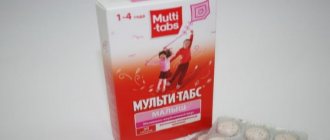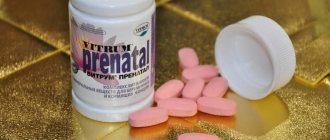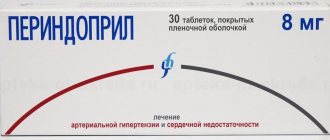Every parent cares about the health of their own child. When kids start getting sick several times a month, or even more often, the question naturally arises of how to help them, because drug treatment has its side effects. It is necessary to stimulate the work of the defense forces of the growing body, and vitamin food supplements that are not drugs cope best with this. "Vitrum Junior" is a biologically active food supplement, indispensable for children over the age of seven, although some experts suggest starting to take them at the age of four.
Compound
One chewable tablet contains:
- retinol acetate (vitamin A) - 5000 IU (which corresponds to the retinol - 1.72 mg);
- thiamine mononitrate (vitamin B1) - 1.5 mg;
- colecalciferol (vitamin D3) - 400 IU (10 mcg);
- riboflavin (vitamin B2) - 1.7 mg;
- calcium pantothenate (vitamin B5) - 10 mg;
- phytomenadione (vitamin K1) - 10 mcg;
- folic acid (vitamin B9) - 400 mcg;
- pyridoxine hydrochloride (vitamin B6) - 2 mg;
- ascorbic acid (vitamin C) - 300 mg;
- cyanocobalamin (vitamin B12) - 6 mcg;
- alpha-tocopherol acetate (vitamin E) - 30 IU (30 mg);
- calcium (in the form of calcium hydrogen phosphate ) - 160 mg;
- nicotinamide (vitamin PP) - 20 mg;
- phosphorus (in the form of calcium hydrogen phosphate ) - 50 mg;
- biotin (vitamin H) - 45 mcg;
- copper (in the form of copper oxide ) - 2 mg;
- manganese (in the form of manganese sulfate ) - 1 mg;
- magnesium (in the form of magnesium oxide ) - 40 mg;
- iron (in the form of ferrous fumarate ) - 18 mg;
- zinc (in the form of zinc oxide ) - 15 mg;
- iodine (in the form of potassium iodide ) - 150 mcg;
- molybdenum (in the form of sodium molybdate ) - 20 mcg;
- chromium (in the form of chromium chloride ) - 20 mcg.
Excipients: sucrose, sorbitol, stearic acid, colloidal silicon dioxide, magnesium stearate, microcrystalline cellulose, orange flavor, citric acid, aspartame, pineapple flavor, yellow dye.
Instructional recommendations
The Vitrum Junior complex is produced by a pharmaceutical company. The main production plants and research laboratories are located in the United States of America, but this does not prevent this series of dietary supplements from being popular all over the world. Due to its unique composition, the drug has a beneficial effect on the functioning of the growing organism.
Release form, components
"Vitrum Junior" is sold in tablet form. The capsules have a brownish tint and a slight fruity odor. They are packaged in quantities from 30 to 90 pieces in polyethylene jars, which in turn are placed in small boxes made of cardboard. The composition of the dietary supplement is filled with vitamin and mineral components, including the following:
| Vitamins per 1 tablet | Content |
| Vitamin A | 1.5 mg |
| Vitamin D3 | 0.01 mg |
| Vitamin E | 20.1 mg |
| Vitamin C | 300 mg |
| Vitamin B1 | 1.5 mg |
| Vitamin B2 | 1.7 mg |
| Vitamin B5 | 10 mg |
| Vitamin B6 | 2 mg |
| Vitamin B12 | 6 mcg |
| Vitamin PP | 20 mg |
| Vitamin H | 45 mcg |
| Vitamin K1 | 10 mcg |
These elements determine the beneficial properties of the drug. However, given the fact that it contains certain excipients, including coloring and flavoring agents, it is worth meeting with a specialist before starting to take them for advice.
| Minerals per 1 tablet | Content |
| Calcium | 160 mg |
| Magnesium | 40 mg |
| Phosphorus | 50 mg |
| Iron | 18 mg |
| Copper | 2 mg |
| Zinc | 15 mg |
| Iodine | 150 mcg |
| Manganese | 1 mg |
| Chromium | 20 mcg |
| Molybdenum | 20 mcg |
Beneficial features
"Vitrum" for children, taken from 7 to 14 years old, has a number of useful properties. These include:
- normalization of growth;
- normalization of the functioning of the visual organs;
- accelerating the healing process of abrasions and bruises;
- strengthening the immune system;
- improvement of metabolic processes;
- increasing resistance to infectious and viral diseases;
- strengthening and normalizing the growth of bone tissue, skeletal formation;
- protection of cellular tissues from damage;
- accelerating the removal of toxic substances from the child’s body;
- development of mental abilities, physical endurance;
- improved appetite;
- normalization of hormonal balance;
- improvement of hematopoietic processes;
- reducing the amount of cholesterol deposits;
- preventing the development of diabetes and other diseases;
- improving the functioning of the kidney organs;
- improving the condition of the skin, hair, nails, teeth.
In addition, the amount of vitamins in the complex is such that it allows you to replenish their daily requirement in a growing body. This is extremely important for strengthening bones and maintaining the functioning of the cardiovascular system. Micro- and macroelements together take care of the normal functioning of the thyroid gland and genitourinary system, and also help normalize sleep and increase stress resistance. This is necessary for a child who begins to attend kindergarten or school and has to adapt to new living conditions.
Indications for use
There are certain indications for which the drug from the Vitrum series is prescribed, intended for children aged 7 years and older. First of all, this is a state of vitamin deficiency, accompanied by frequent diseases of a viral, infectious nature, increased fatigue, and low appetite. Other situations requiring the use of this complex include:
- recovery period after suffering a severe pathological condition;
- a period of increased stress, causing an increase in mental and physical activity;
- unbalanced diet;
- living in environmentally unfavorable areas.
Self-administration of the drug is allowed only for preventive purposes once in the fall and spring. The instructions for the drug emphasize this, indicating that if a question arises about repeating the course, it is better to consult a doctor.
Contraindications
Despite the fact that such a complex from the Vitrum line as “Junior” contains a sufficient amount of vitamins, there are situations when it is better not to use it. Otherwise, the child's condition may deteriorate so much that he will end up in a local hospital. The main contraindications to taking the drug are:
- hypervitaminosis of particles belonging to vitamin groups A and D;
- children under four years of age;
- individual intolerance to the components of the complex;
- hypercalcemia;
- hypermagnesemia;
- hyperkalemia;
- nephrolitasis;
- failure of renal organs;
- thyrotoxicosis;
- peptic ulcer of the stomach and duodenum;
- thrombophlebitis.
Particular caution should be taken when taking a dietary supplement if a child suffers from diabetes mellitus, chronic pancreatitis, or dysfunction of the thyroid gland. It is important to remember that while taking this dietary supplement, other complexes are not used, as an overdose may develop.
Side effects
The composition of such a complex from the Vitrum line as “Junior” characterizes it on the positive side. However, if the dosage specified in the instructions is not followed, side effects may develop. These include:
- nausea;
- pain in the abdominal area;
- vomit;
- the appearance of a rash on the skin;
- painful sensations reminiscent of migraine symptoms.
In such situations, they refuse to take the complex and go to a doctor for advice. Most likely, he will prescribe medication according to the situation and recommend a similar vitamin preparation. Side effects not caused by an overdose include:
- hives;
- allergic reactions;
- dyspeptic disorders;
- increased excitability.
If these side effects occur, the drug should also be discontinued. It is extremely important not to continue taking it as serious health problems may occur. It is possible that the child’s urine may turn a brighter orange color, which is normal during the period of using the vitamin complex.
How to use?
Vitrum for children over 7 years of age is taken daily for a month. During meals, the child should take one capsule, chew it, and, if necessary, drink it with the appropriate amount of purified liquid, that is, water. Children over the age of four are allowed to take half a capsule once a day, chewing it and drinking water.
The preventive course of the complex is one month. However, if parents consider it advisable to contact a specialist to decide on further admission, this should be done quickly enough. Usually the interval between two or three courses of the drug is no more than two weeks. Most often, experts recommend taking the product in the spring and autumn months, when the body most needs protection.
Pharmacodynamics and pharmacokinetics
Pharmacodynamics
Vitrum Junior is a balanced complex of minerals and vitamins for teenagers and children. Promotes harmonization of the functioning of the body, increases resistance to infectious organisms, activates recovery processes after diseases and injuries. Recommended for unbalanced diets and eating disorders.
Vitamin A is involved in ensuring the normal course of metabolic processes, as well as in regulating the development and growth of the body. Normalizes the function of the organ of vision, increases the body's resistance to the effects of hostile environmental factors.
Vitamin D3 increases the absorption of calcium in the intestines and phosphorus in the kidneys, ensuring the proper construction of the skeleton and teeth in children.
Vitamin E is an antioxidant that inhibits fat oxidation, which accelerates in most diseases. Prevents damage to cell components by oxygen free radicals. Participates in the processes of cellular respiration, heme and protein synthesis, lipid and carbohydrate metabolism, cell differentiation and many others.
Vitamin C is involved in many types of redox reactions, regulation of carbohydrate metabolism, affects amino acid metabolism, biosynthesis of catecholamines , metabolism of thyroxine , steroid hormones and insulin . Regulates capillary permeability. Increases the absorption of iron in the digestive tract and is involved in the biosynthesis of hemoglobin . Has antitoxic properties. Necessary for the restoration of bone and connective tissue, collagen synthesis.
Vitamin B1 normalizes the functioning of the digestive, nervous, endocrine system and cardiac activity.
Vitamin B2 promotes the growth process of the body. Supports the processes of nonspecific immune response, normal eye function, affects the development of the nervous system and is involved in the synthesis of Erythropoietin and hemoglobin . Activates the secretory function of the stomach, helps the absorption of carbohydrates in the intestines, and is essential for maintaining healthy microflora .
Vitamin B12 is characterized by high bioactivity and is involved in all types of metabolism. Accelerates regeneration processes, regulates hematopoiesis, functions of the nervous system and liver, plays a role in blood clotting.
Vitamin B6 is an integral part of proteins involved in the metabolism of amino acids and fat metabolism. Necessary for the proper functioning of the nervous system.
Folic acid is required for the proper functioning of erythropoiesis processes. Participant in the biosynthesis of amino acids and DNA.
Nicotinamide stimulates the production of nicotine adenine dinucleotide and nicotine adenine dinucleotide phosphate . These substances transfer protons in oxidation-reduction reactions, which ensures the normal movement of metabolic biochemical operations.
Biotin (vitamin H) is a component of enzymes that regulate lipid and protein metabolism. Necessary for the biosynthesis of higher fatty acids and some other acids.
Pantothenic acid activates the formation of corticosteroids. Participates in lipid and carbohydrate metabolism, acetylcholine production. Provides proper energy supply to the myocardium, accelerates tissue regeneration processes.
Vitamin K1 is an active component of proteins that ensure a normal level of coagulation. Participates in metabolic processes in connective tissue and bones. This vitamin ensures the absorption of calcium and the interaction of calcium and vitamin D.
Calcium takes part in the formation of nerve impulses, in ensuring the motor function of smooth and skeletal muscles, myocardium , and in the development of bone tissue.
Phosphorus is a structural part of all nucleic acids, nucleotides, phospholipids, phosphoproteins, coenzymes, enzymes , an important element of tooth enamel and bones.
Magnesium ensures many metabolic processes, neuromuscular excitability and conductivity, and reduces the concentration of acetylcholine in the cells of the nervous system.
Copper is a participant in redox reactions and protects the body from the effects of free radicals.
Iron is an essential component of the structure of myoglobin, hemoglobin, cytochromes, and is also a participant in a number of redox reactions. Without iron, hematopoiesis is impossible.
Zinc makes an important contribution to the biosynthesis of insulin, DNA, RNA, the metabolism of fats and proteins, and promotes the proper functioning of T-lymphocytes . Is an antioxidant.
Manganese (in the form of a structural element and an enzyme activator) is a participant in a number of physiological processes.
Iodine is a necessary component of thyroid hormone involved in the establishment of metabolic processes, in the activity of the brain, cardiovascular and nervous systems, human development, and the formation of his mental abilities.
Molybdenum prevents the body from losing fluoride . It has the ability to activate the destruction of purines and the excretion of uric acid .
Chromium enhances the effects of insulin .
Pharmacokinetics
There are no data on the pharmacokinetics of the drug.
Properties
Vitamin A is necessary for the normal course of metabolic processes, including the regulation of growth and development of the body. Ensures normal function of the organ of vision, structural integrity of tissues, increases the body's resistance to the effects of harmful environmental factors.
Vitamin E is an active antioxidant, inhibits LPO, which increases in many diseases, and prevents damage to cellular structures by free radicals. Participates in the processes of tissue respiration, biosynthesis of heme and proteins, metabolism of fats and carbohydrates, cell proliferation and other metabolic processes.
Vitamin D 3 enhances the absorption of calcium in the intestine and the reabsorption of phosphorus in the renal tubules, normalizes the formation of the bone skeleton and teeth in children, and helps preserve bone structure.
Vitamin C has pronounced restorative properties. Participates in redox processes, regulation of carbohydrate metabolism, affects the metabolism of aromatic amino acids, thyroxine metabolism, biosynthesis of catecholamines, steroid hormones and insulin; necessary for blood clotting, collagen and procollagen synthesis, regeneration of connective and bone tissue. Normalizes capillary permeability. Promotes the absorption of iron in the intestines and participates in the synthesis of hemoglobin. Increases the body's nonspecific resistance and has antioxidant properties.
Vitamin B 1 is necessary for the normal functioning of the nervous and digestive systems, cardiac activity and endocrine glands.
Vitamin B 2 is involved in growth processes. Supports the process of phagocytosis, affects the morphology and function of the central nervous system and the autonomic nervous system, plays an important role in maintaining normal visual function of the eye and in the synthesis of erythropoietin and hemoglobin. Increases the secretory function of the stomach, improves bile secretion, facilitates the absorption of carbohydrates in the small intestine, and is necessary for maintaining normal intestinal microflora. Improves liver function, promotes insulin incretion.
Vitamin B 6 is part of enzymes involved in the processes of decarboxylation and transamination of amino acids and lipid metabolism. Necessary for the normal functioning of the central nervous system and peripheral nervous system.
Vitamin B 12 has high biological activity and is involved in hydrocarbon, protein, and fat metabolism. Increases tissue regeneration, normalizes hematopoiesis, liver and nervous system functions.
Folic acid is necessary for the normal maturation of megaloblasts and the formation of normoblasts. Stimulates erythropoiesis, participates in the synthesis of amino acids, nucleic acids, purines and pyrimidines, as well as in choline metabolism.
Nicotinamide substrate stimulates the synthesis of nicotine adenine dinucleotide (NAD) and nicotine adenine dinucleotide phosphate (NADP). In the form of NAD and NADP, it accepts and transfers protons in many redox reactions, ensuring the normal course of many types of metabolism, including energy.
Pantothenic acid stimulates the formation of corticosteroids and is a substrate for the synthesis of acetylation coenzymes. Participates in carbohydrate and fat metabolism, the synthesis of acetylcholine and corticosteroids. Optimizes the energy supply of myocardial contractility, improves regeneration processes.
Biotin (vitamin H) is part of enzymes that regulate protein and lipid metabolism. It is a coenzyme of carboxylation, therefore it is necessary for the synthesis of higher fatty acids and oxaloacetic acid. Participates in the synthesis of purines, which are part of nucleic acids and nucleotides.
Vitamin K 1 is necessary for the synthesis of proteins that provide a sufficient level of coagulation. Plays an important role in metabolism in bones and connective tissue, as well as in kidney function. In all these cases, the vitamin is involved in the absorption of calcium and in ensuring the interaction of calcium and vitamin D.
Calcium ions are involved in the transmission of nerve impulses, in the contraction of skeletal and smooth muscles, myocardium, in blood sedimentation, in the formation and preservation of the integrity of bone tissue.
Phosphorus is part of nucleotides, nucleic acids, phosphoproteins, phospholipids, coenzymes, enzymes, and is an important element in the composition of bones and tooth enamel.
Magnesium regulates metabolic processes, neurochemical transmission and muscle excitability, reduces the amount of acetylcholine in the central nervous system and peripheral nervous systems.
Iron is part of hemoglobin, myoglobin, cytochromes, participates in a number of redox reactions, and plays an important role in hematopoietic processes.
Copper plays an important role in redox reactions and protecting the body from free radicals.
Zinc is involved in the synthesis of DNA, insulin, synthesis and breakdown of RNA, in the metabolism of lipids and proteins, promotes the normal functioning of T-lymphocytes, providing them with immunomodulating properties. Has antioxidant properties.
Manganese plays an important role in a number of physiological processes as a component and activator of a number of enzymes, including superoxide dismutase (the main antioxidant enzyme of mitochondria).
Iodine is a component of thyroid hormones, which are involved in the regulation of metabolic processes in the body, the activity of the brain, nervous and cardiovascular systems, the growth and development of the child, and the formation of his intellectual abilities.
Indications for use
- Regulation of conditions associated with an increased need for vitamins (period of rapid growth, rehabilitation after illness, intense physical and mental stress).
- Prevention and treatment of mineral and vitamin deficiency in adolescents and children.
- Decreased resistance to infections.
- Unbalanced and inadequate nutrition, impaired absorption of minerals and vitamins.
- Maintenance treatment for chronic diseases, after operations, active therapy with antibacterial and chemotherapeutic agents.
Recommendations for use
Vitamin-mineral complex of 13 vitamins and 7 minerals in chewable tablets with a pleasant fruit taste - can be recommended for use in children’s diets as an additional source of vitamins: A, D3, E, C, B1, B2, B6, B12, B3 (nicotinamide), B5 (pantothenic acid), vitamin K1, folic acid, D-biotin, and minerals: calcium, magnesium, iron, zinc, manganese, copper, iodine.
Replenishing the lack of vitamins and minerals in children aged 7–14 years.
Helps maintain the optimal composition of the child’s diet, promotes:
- proper physical and intellectual development of the child;
- strengthening the child’s body’s defenses during the season of colds;
- maintaining the optimal functional state of the nervous system during the period of adaptation to school.
Contraindications
- Hypercalcemia, hypermagnesemia, hypercalciuria , chronic glomerulonephritis, renal failure, nephrolithiasis, sarcoidosis, hypervitaminosis E, A and D, active pulmonary tuberculosis , malabsorption syndrome, fructose intolerance, thrombophlebitis , impaired copper or iron , severe kidney disease, gout , erythrocytosis , chronic cardiac failure , thyrotoxicosis, gastric or duodenal ulcer , joint use of retinoids.
- Hypersensitivity to the drug or its components.
- Children's age up to 4 years.
Side effects
In rare cases, the following side effects may occur.
- From the skin: urticaria , rash, hyperemia, itching.
- From the immune : Quincke's edema , anaphylactic shock , fever and other allergic reactions.
- From the digestive system: nausea, dyspeptic disorders, vomiting, abdominal pain, constipation, diarrhea , increased acidity, heartburn .
- From the central nervous system: headache, dizziness, excitability.
With long-term use in large doses, the following may occur: irritation of the mucous membranes, hypercalciuria, hypercalcemia, arrhythmias, hyperuricemia, dry skin, paresthesia, hyperglycemia, temporary increase in the activity of alkaline phosphatase and liver enzymes, seborrheic rash.
Interaction
The calcium and iron content in the drug inhibits the absorption tetracycline antibiotics and fluoroquinolones in the digestive tract.
Ascorbic acid activates the action of sulfonamides .
Iron and silver supplements interfere with the absorption of vitamin E.
Antacids containing calcium, magnesium, aluminum, and cholestyramine reduce the bioavailability of iron .
Vitrum Junior plus, chewable tablets, 30 pcs.
Compound:
brown sugar, calcium phosphate, acidity regulator citric acid, vitamin C (ascorbic acid, sodium ascorbate), magnesium oxide, niacinamide, stabilizer magnesium salt of stearic acid, stabilizer silicon dioxide, ferric fumarate, carrier microcrystalline cellulose, vitamin E acetate, stabilizer steric acid , natural orange flavor (maltodextrin, natural orange flavor, acidity regulator citric acid, antioxidant butylated hydroxytoluene), zinc oxide, vitamin B6 (pyridoxine hydrochloride), vitamin B2 (riboflavin), vitamin B5 (calcium pantothenate), vitamin B1 (thiamine mononitrate), Vitamin A acetate, folic acid, vitamin D3 (cholecalciferol), manganese sulfate, biotin, natural pineapple flavor (dextrose, natural pineapple flavor, silicon dioxide stabilizer), vitamin K1 (phytomenadione), copper carbonate, potassium iodide, yellow iron oxide dye, vitamin B12 (cyanocobalamin)
1 chewable tablet contains:
| Active ingredient | Content in recommended daily intake (1 tablet of 1200 mg), mg | % of recommended daily requirement** | ||
| Children 7-11 years old | Boys 11-14 years old | Girls 11-14 years old | ||
| Vitamin A | 0,466 (0,419-0,699) | 66 (60-100) | 47 (42-70) | 58 (52,5-87) |
| Vitamin D3, mcg | 6,6 (6-9,9) | 66 (60-99) | 66 (60-99) | 66 (60-99) |
| Vitamin E, TE | 8,9 (8-13,4) | 89 (80 −134)* | 74,2 (66,7- 111,7)* | 74,2 (66,7- 111,7)* |
| Vitamin C | 80 (72-120) | 133 (120-200)* | 114 (103-171)* | 133 (120-200)* |
| Vitamin B1 | 1,466 (1,319-2,199) | 133 (120-200)* | 113 (101-169)* | 113 (101-169)* |
| Vitamin B2 | 1,6 (1,44-2,4) | 133 (120-200)* | 107 (96-160)* | 107 (96-160)** |
| Vitamin B6 | 2 (1,8-3) | 133 (120-200)* | 118 (106-176)* | 125 (112,5-187,5)* |
| Vitamin B12, mcg | 2,6 (2,4-3,9) | 130 (120-195)* | 87 (80-130)* | 87 (80-130)* |
| Niacinamide | 20 (18-30) | 133 (120-200)* | 111 (100-167)* | 111 (100-167)* |
| Vitamin K1, mcg | 10 (9-16) | 17 (15-27) | 12,5 (11-20) | 14 (13-23) |
| Pantothenic acid | 4 (3,6-6) | 133 (120-200)* | 114 (103-171)* | 114 (103-171)* |
| Folic acid | 0,266 (0,240-0,399) | 133 (120-200)* | 67-89 (60-133)* | 67-89 (60-133)* |
| Biotin, mcg | 26 (23,4-39) | 130 (117-195)* | 104 (93-156)* | 104 (93-156)* |
| Calcium | 160 (144-200) | 14,5(13-18) | 13 (12-17) | 13 (12-17) |
| Magnesium | 45 (40,5-56,2) | 18(16-22) | 15 (13,5-19) | 15 (13,5-19) |
| Zinc | 8 (7,2-10) | 80(72-100) | 67(60-83) | 67(60-83) |
| Iodine, mcg | 75 (67,5-120) | 62,5 (56-100) | 58 (52-92) | 50 (45-80) |
| Iron | 9,6 (8,64-12) | 80 (72-100) | 80 (72-100) | 64 (58-80) |
| Copper | 0,56 (0,504-0,7) | 80 (72-100) | 70 (63-87,5) | 70 (63-87,5) |
| Manganese | 1 (0,9-1,25) | 50 (45-62,5)** | 50 (45-62,5)*** | 50 (45-62,5)*** |
*Does not exceed the upper permissible consumption level.
** According to MP 2.3.1.2432-08 “Norms of physiological needs for energy and nutrients for various groups of the population of the Russian Federation”;
***% of the adequate level of consumption according to the “Unified Sanitary-Epidemiological and Hygienic Requirements for Goods Subject to Sanitary-Epidemiological Surveillance (Control)” (Chapter II, Section 1, Appendix 5);
Vitamin A
- responsible for the formation of antiviral immunity, supports vision during exercise, promotes normal growth and physical development of the child.
Vitamin D (cholecalciferol)
- responsible for the normal development of the child’s skeleton, regulates calcium metabolism, the tone of the nervous system, the normal ratio of sleep and wakefulness, is responsible for the formation of antibacterial immunity, promotes the development of muscles and the cardiovascular system.
Vitamin C (ascorbic acid)
– increases the body’s resistance to infection, helps the body adapt to low winter temperatures.
Vitamin B1 (thiamine)
- promotes better memorization of information, normalizes sleep, accelerates wound healing, increases body tone in winter, counteracts the effects of food and respiratory toxins.
Vitamin B2 (riboflavin)
— maintains visual acuity, improves exercise tolerance, adapts the body when exposed to stress.
Vitamin B6 - (pyridoxine)
- regulates appetite, reduces nervous and physical fatigue, improves muscle tone.
Vitamin B12 (cyanocobalamin) and Vitamin B9 (folic acid)
- support the body during stress, increase resistance to stressful situations, improve mood, and participate in hematopoiesis.
Vitamin B3 (Niacinamide)
- regulates normal cardiac activity, normalizes digestive functions, improves appetite, and counteracts depression.
Vitamin B5 (Pantothenic acid)
– improves concentration, promotes healthy skin and hair, protects the body during stress.
Vitamin B7 (Biotin)
- also protects the body during stress, is responsible for hair growth and normal skin function, regulates glucose metabolism.
Zinc
- realizes the effect of vitamin A, increases resistance to stress and colds, improves coordination, memory and attention, is necessary for normal hair and nail growth, and promotes wound healing.
Iodine
- promotes normal physical and mental development, regulates the functioning of the immune system.
Iron
- stimulates hematopoiesis and development of the muscular system.
Copper and manganese
— ensure iron metabolism, normal immune response, regulate carbohydrate metabolism.
special instructions
The drug should be used with caution in case of liver diseases, cholelithiasis , previous duodenal and gastric ulcers , diabetes mellitus , chronic pancreatitis .
Since the drug contains iodine , the advisability of taking it in persons with thyroid dysfunction is determined by the attending physician.
It is not recommended to use Vitrum Junior in combination with other multivitamin complexes, because an overdose is possible.
Warning
It should not be used by children with individual intolerance to the components of the product or impaired carbohydrate metabolism. This product is not intended to diagnose, treat, cure, or prevent any disease and should not be used as a substitute for various diets. Before use, you should consult your pediatrician. Children with thyroid disease should consult an endocrinologist. Do not exceed the recommended daily dose. Do not consume after the expiration date indicated on the package.
Not a medicine.
Analogs
Level 4 ATX code matches:
Vitacap
Glutamevit
Bio-Max
Menopace
Lavita
Wellman
Teravit
Gerovital
Kaltsinova
Pregnakea
Oligovit
Multi-Tabs Intensive
Multi-Tabs Junior
Multi-Tabs Perinatal
Multi-Tabs Teen
Multi-Tabs Classic
Multi-Tabs Baby
Special Dragee Merz
Pregnavite
Complivit Trimester
Analogues of Vitrum Junior are Multimax Kinder , Multimax Junior , Actival Kids , Jungle Kids , Multi-Tabs Junior .
Vitrum Junior price, where to buy
In Russia, the price of 30 tablets of this vitamin complex is 260-300 rubles, in Ukraine it fluctuates around 82-104 hryvnia.
- Online pharmacies in RussiaRussia
- Online pharmacies in UkraineUkraine
- Online pharmacies in KazakhstanKazakhstan
Pharmacy Dialogue
- Vitrum Junior chewable tablets No. 30 Unipharm
467 RUR order
show more
PaniPharmacy
- Vitrum Junior tab.
chewing No. 60, Unipharm 234 UAH. order
show more






